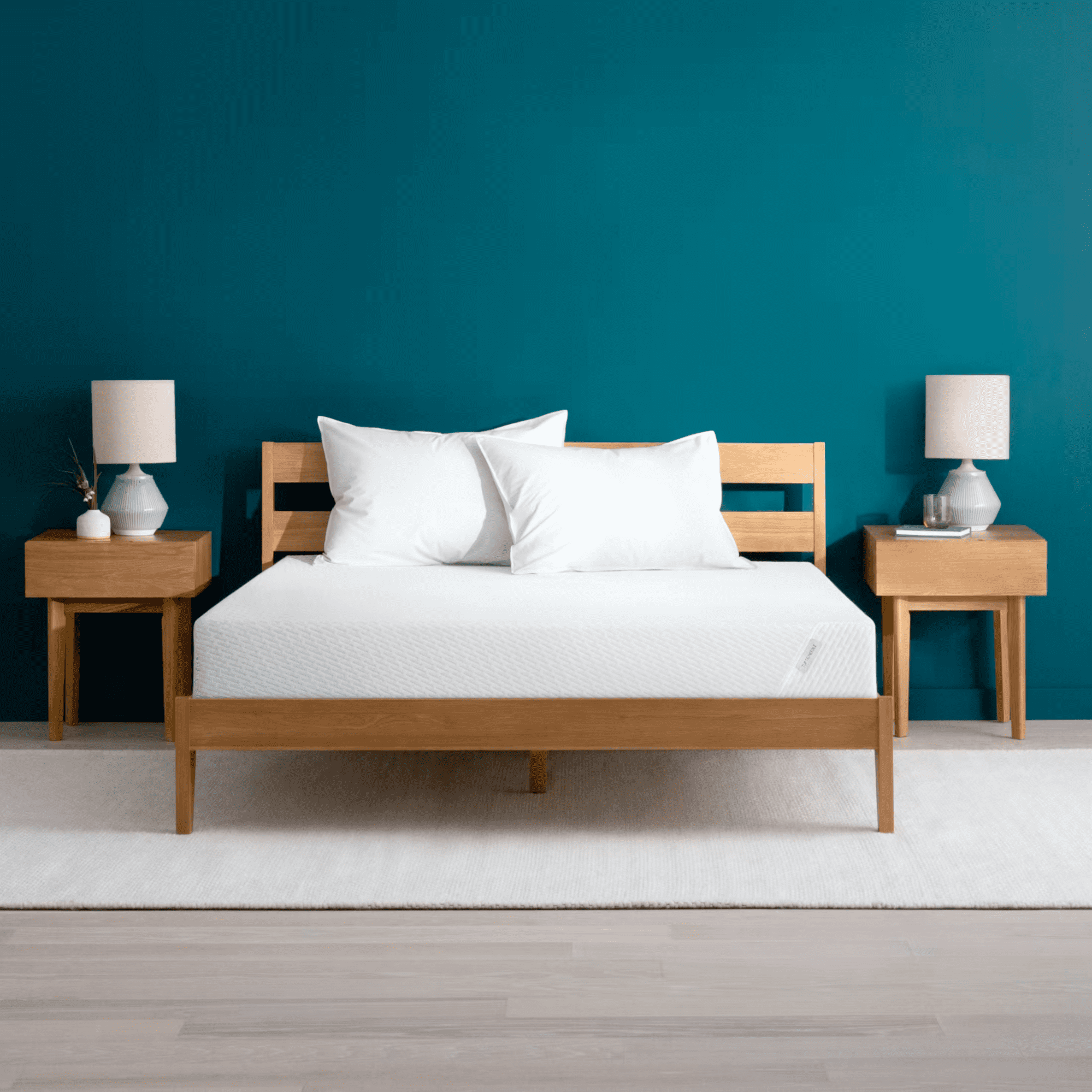The queen is one of the standard mattress sizes. Although specific dimensions can vary by brand, a typical queen-size bed measures 60 inches wide by 80 inches long. As you can see from the table below, the queen is considered a mid-level mattress size.
Mattress Size | Dimensions (W x L) |
|---|---|
38″ x 75″ | |
38″ x 80″ | |
53″ x 75″ | |
60″ x 80″ | |
76″ x 80″ | |
72″ x 84″ |
Because these mattresses are so common, most bed frame manufacturers carry products to accommodate queen-size models.
Queen Mattress Variations
In addition to the standard queen size, mattress and bed frame shoppers can choose from a few queen variations.
- Short queen: This size is best suited to RVs and guest rooms, as well as people who find standard queens too long. A short queen usually measures 53 inches wide by 60 inches long.
- Olympic queen: The Olympic queen offers more width than a standard queen, which may be better for some couples. This size typically measures 66 inches wide by 80 inches long.
- California queen: This size is longer than a standard queen and may be the best option for exceptionally tall people. California queens generally measure 60 inches wide by 84 inches long.
A custom queen may be more suitable than a standard queen depending on your height, your bedroom’s dimensions, and whether you sleep with a partner. The downside is that the bed frame you want may not be readily available in any of these sizes, in which case you’ll need to find a new model or opt for a more expensive custom-size frame.
Queen Size Beds
A queen-size bed frame’s dimensions will accommodate a mattress that measures 60 inches wide by 80 inches long. However, the frame itself will take up more room. The amount of extra space needed will depend on the specific frame model. In some cases, the frame will only be two to three inches wider and/or longer than the mattress, but a queen-size frame can potentially measure up to 75 inches wide by 90 inches long.
Bed frame height is another consideration. Including the legs, a standalone platform bed typically measures 10 to 14 inches tall. Add a headboard and posts, and the height will probably increase to 40 inches or taller. Before choosing a bed frame, measure your bedroom (or the room where you plan to use the frame) to ensure you have sufficient space.
Also, double-check your mattress warranty. Many mattress warranties list explicit requirements for bed frame materials and dimensions. The distance between slats is a common restriction; some manufacturers will void the warranty if the mattress is used on a frame with slats measuring more than two or three inches apart and damage to the bed occurs. The warranty may also prohibit certain bed frame types.
Types of Bed Frames
Common types of bed frames include:
Platform
A platform bed is an elevated surface designed with evenly spaced slats made of wood or metal. Most queen-size platform beds have four legs, as well as a fifth leg in the center for added support; many mattress warranties require at least five legs for a queen-size model.
Unlike traditional beds, platform beds do not require a boxspring or foundation. You may place the mattress directly on the platform bed. If the slates are too far apart, though, this can cause your mattress to sag excessively.
Sleigh
Sleigh beds get their name from their curved headboards and footboards, which resemble the shape of classic sleighs. Most sleigh beds are made of solid wood and have a slatted surface to support the mattress. Sleigh beds generally have shorter legs, leaving eight inches or less between the rails and the floor. Typical dimensions include a headboard of 35 to 50 inches tall, and a footboard of 15 to 30 inches tall.
You should use a boxspring or foundation for your mattress if you choose a sleigh bed. For many sleigh beds, the slats are not spaced closely enough to accommodate a mattress and meet warranty requirements. If the slats are too wide, the mattress will begin to sag and lose support over time.
Shop the Best Queen MattressesPoster
As the name implies, these beds are constructed with a tall post at each of the four corners. The most common type is the four-poster bed, which features tall posts that usually measure 60 to 80 inches tall from the floor. You can also select a low-poster if your bedroom has relatively low ceilings.
Poster beds also include a headboard and footboard. On standard poster beds, all four posts will share the same height. On models known as half-poster beds, the headboard posts will be roughly twice as tall as the footboard posts. Another variation is the canopy bed, which connects all four posts with a fabric covering that may also include curtains for extra privacy.
You should use a boxspring or foundation with your mattress on a poster bed. As with sleigh beds, the slats on most poster and canopy beds are spaced too far from one another.
Storage
A storage bed is equipped with drawers on one or both sides. You can use these compartments to store pillows, bedding, and other belongings. These beds can be quite handy if your bedroom is somewhat small and you’d like to conserve floor space.
Bed Frame Type | Platform | Sleigh | Four-Poster | Canopy | Storage |
|---|---|---|---|---|---|
Features | Slatted base; May include headboard and footboard | Curved headboard and footboard | Headboard and footboard with 4 corner posts | Headboard, footboard, and 4 corner posts connected with a canopy | Slatted platform base with headboard; |
Number of Legs | 4+ with center leg support | 4 | 4 | 4 | 4+ with center leg support |
Boxspring or Foundation Needed? | No | Yes | Yes | Yes | No |
Avg. Height | 10″ to 14″ | 35″ to 50″ (headboard) | 60″ to 80″ | 60″ to 80″ | 40″ to 55″ (headboard) |
Avg. Price Range (Queen) | $300 to $700 | $500 to $1000 | $400 to $800 | $700 to $1300 | $400 to $800 |
Our list of bed frame types is not exhaustive. When shopping for a new bed frame, you’ll be able to choose from a wide range of styles. However, it’s important to note that some other bed types are rarely available in a queen size.
Take, for example, the day bed. These beds have a plush surface encased in a three-sided steel frame; one of the lengthwise sides is left open, allowing you to use the surface as a sofa during the day and a bed at night. Day beds are versatile and space-efficient – but they’re rarely available in larger than a full or double size. The same is true of trundle beds, which feature a standard bed frame equipped with a spare mattress that can be pulled out using a side drawer.
Who Is a Queen Mattress Best for?
You are a good candidate for a queen-size mattress if:
- You share your bed with a partner
- Your bedroom is sufficiently wide and long enough to accommodate a mattress that measures 60 inches wide x 80 inches long
- You stand 6 feet 7 inches (79 inches) or shorter
You should consider a mattress size other than queen if:
- You sleep alone and your bedroom is somewhat cramped
- You stand 6 feet 8 inches (80 inches) or taller
Ask the Sleep Doctor
Have questions about sleep? Submit them here! We use your questions to help us decide topics for future articles, videos, and newsletters. We try to answer as many questions as possible. You can also send us an email. Please note, we cannot provide specific medical advice, and always recommend you contact your doctor for any medical matters.







